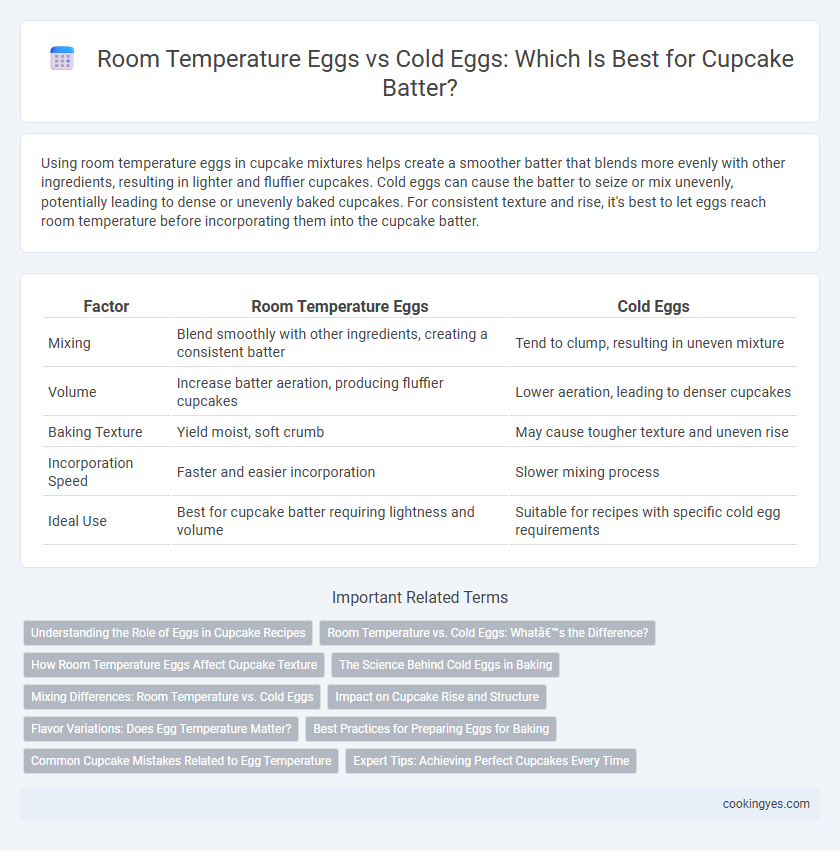Using room temperature eggs in cupcake mixtures helps create a smoother batter that blends more evenly with other ingredients, resulting in lighter and fluffier cupcakes. Cold eggs can cause the batter to seize or mix unevenly, potentially leading to dense or unevenly baked cupcakes. For consistent texture and rise, it's best to let eggs reach room temperature before incorporating them into the cupcake batter.
Table of Comparison
| Factor | Room Temperature Eggs | Cold Eggs |
|---|---|---|
| Mixing | Blend smoothly with other ingredients, creating a consistent batter | Tend to clump, resulting in uneven mixture |
| Volume | Increase batter aeration, producing fluffier cupcakes | Lower aeration, leading to denser cupcakes |
| Baking Texture | Yield moist, soft crumb | May cause tougher texture and uneven rise |
| Incorporation Speed | Faster and easier incorporation | Slower mixing process |
| Ideal Use | Best for cupcake batter requiring lightness and volume | Suitable for recipes with specific cold egg requirements |
Understanding the Role of Eggs in Cupcake Recipes
Eggs play a crucial role in cupcake recipes by providing structure, moisture, and leavening to the batter. Room temperature eggs mix more evenly with other ingredients, resulting in a smoother and more aerated cupcake mixture that rises better and has a tender crumb. Cold eggs can cause the batter to curdle or mix unevenly, negatively affecting texture and volume.
Room Temperature vs. Cold Eggs: What’s the Difference?
Room temperature eggs blend more easily into cupcake batter, promoting a smoother, more consistent texture by allowing fats and liquids to emulsify better. Cold eggs can cause the batter to curdle or mix unevenly, potentially resulting in dense or uneven cupcakes. Using room temperature eggs helps achieve a lighter crumb and improved volume in cupcake mixtures.
How Room Temperature Eggs Affect Cupcake Texture
Using room temperature eggs in cupcake batter helps create a smoother, more uniform mixture that traps air effectively, resulting in a lighter and fluffier cupcake texture. Cold eggs can cause the batter to seize or curdle, leading to denser, less tender cupcakes. Room temperature eggs also blend better with softened butter and other ingredients, promoting even baking and optimal rise.
The Science Behind Cold Eggs in Baking
Cold eggs slow the emulsification process in cupcake batter, resulting in thicker mixtures that trap less air, which may produce denser cupcakes. The lower temperature inhibits the proteins from unfolding quickly, limiting their ability to stabilize air bubbles during mixing. Scientific studies reveal that room temperature eggs create better volume and lighter texture by facilitating optimal protein interactions and emulsification.
Mixing Differences: Room Temperature vs. Cold Eggs
Room temperature eggs blend more smoothly into cupcake batter, creating a uniform mixture that traps air effectively for a lighter, fluffier texture. Cold eggs can cause the batter to seize or curdle, resulting in uneven mixing and denser cupcakes. Properly warmed eggs improve emulsification between fats and liquids, enhancing overall batter consistency.
Impact on Cupcake Rise and Structure
Room temperature eggs incorporate more air when beaten, enhancing the cupcake's rise and resulting in a lighter, fluffier texture. Cold eggs tend to produce denser batters as their lower temperature slows the emulsification process, reducing volume and affecting the cupcake's crumb structure. Using room temperature eggs optimizes aeration and stability in the batter, leading to better leavening and a tender crumb.
Flavor Variations: Does Egg Temperature Matter?
Room temperature eggs blend more evenly into cupcake batter, enhancing texture and allowing flavors like vanilla and cocoa to develop fully. Cold eggs can cause uneven mixing, resulting in pockets of batter with less consistent flavor and a denser crumb. Buttercream and sponge cupcakes often taste richer and fluffier when made with room temperature eggs due to better emulsification and air incorporation.
Best Practices for Preparing Eggs for Baking
Using room temperature eggs in cupcake mixtures ensures better emulsification and even folding, resulting in a lighter, fluffier texture. Cold eggs can cause the batter to curdle or mix unevenly, hindering volume and crumb structure. For optimal cupcake results, let eggs sit at room temperature for 30 minutes before baking to enhance ingredient integration and consistent rise.
Common Cupcake Mistakes Related to Egg Temperature
Using cold eggs directly from the refrigerator in cupcake batter often results in uneven mixing, leading to dense or lumpy cupcakes. Room temperature eggs incorporate more smoothly with sugar and butter, promoting better aeration and a lighter, fluffier texture. A common cupcake mistake is neglecting to bring eggs to room temperature before baking, which can compromise the final crumb and rise of the cupcakes.
Expert Tips: Achieving Perfect Cupcakes Every Time
Using room temperature eggs in cupcake mixtures ensures better emulsification, resulting in a smoother batter and lighter crumb texture. Cold eggs can cause uneven mixing and hinder the incorporation of air, leading to dense cupcakes. Expert bakers recommend allowing eggs to sit at room temperature for 30 minutes before use to consistently achieve perfect rise and softness.
Room Temperature Eggs vs Cold Eggs for Cupcake Mixture Infographic

 cookingyes.com
cookingyes.com